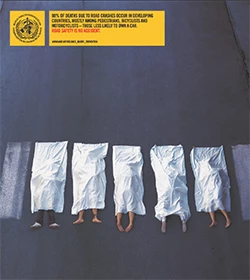
I was saddened not just by the loss of life but because a “road crash” is not a random event: it can be prevented by the adoption of measures that are clearly outlined in the five pillars of the ongoing 2011-2020 UN Decade of Action for Road Safety, which is supported by 103 countries worldwide.
Let me elaborate. Four of the five pillars of the Decade of Action are geared to:
- Strengthening institutional capacity to further national road safety efforts, including activities such as establishing a lead agency for road safety in the country involving partners from a range of sectors and developing a national road safety strategy.
- Influencing safety road design and network management to make roads safer for users, particularly the vulnerable (pedestrians, cyclists, children, the elderly, bus passengers) and reducing severity of crashes.
- Making vehicles safer by adopting motor vehicle safety standards; implementing new car safety assessment programs; and ensuring that all new cars are equipped with seat belts that meet regulatory requirements and pass applicable crash test standards; and
- Influencing road user behavior through sustained enforcement of road traffic laws and standards and rules combined with public awareness/education activities.
According to the news accounts, a preliminary investigation found that the bus had several certification problems: its roadworthiness certificate had not been renewed as mandated by the law; the original expired certificate had been issued by a testing station that had been closed down for fraud; and braking problems in the vehicle appeared to have caused the crash as the driver had tried to stop the bus by entering a sandy, slowing lane before losing control.
The causes that appear to have led to this bus crash can be tackled. Measures to do this include:
- Strengthening systems to inspect vehicles and prevent the issuance of forged operating licenses.
- Promoting better education and training of professional drivers.
- Enhancing policing to enforce existing laws and regulations on aspects such as speeding, reckless driving, drinking when driving, and seat belt and helmet use.
- Rethinking road design to make better use of rail barriers on the side of the roads to prevent cars from turning over or on the center line of roads to stop head-on collisions.
Despite the systemic failures that led to this bus crash, the elements of pillar 5 of the Decade of Action, which aims to improve post-crash care, were in place and responded well. Western Cape Province Emergency Medical Services teams were dispatched promptly to the scene of the accident to care for the injured and transport them in ambulances or rescue helicopters to hospitals and clinics around the Province. A pre-hospital screening process helped prevent further loss of life by determining the appropriate health facility to transport patients to, rather than sending them to the nearest facility which might not have been able to offer needed care.
I think this deadly crash in South Africa illustrates and reinforces the need for a multisectoral and systematic response to reduce road traffic injuries. These injuries cause both human grief and high economic costs due to loss of household earnings when a breadwinner dies, costly trauma care and rehabilitation services, damage to vehicles and property, and insurance and disability pay-outs.
The multilateral development banks, including the World Bank, have committed to support countries in developing sustainable “safe systems” to prevent road traffic casualties. So we should be optimistic that the Decade of Action, if implemented as envisioned, will help arrest the spread of this growing public health problem. But, to accomplish the Decade’s ambitious goal of stabilizing and then reducing road deaths by 2020, the time to act in a multisectoral manner is now.
Photo credit: World Health Organization


Join the Conversation